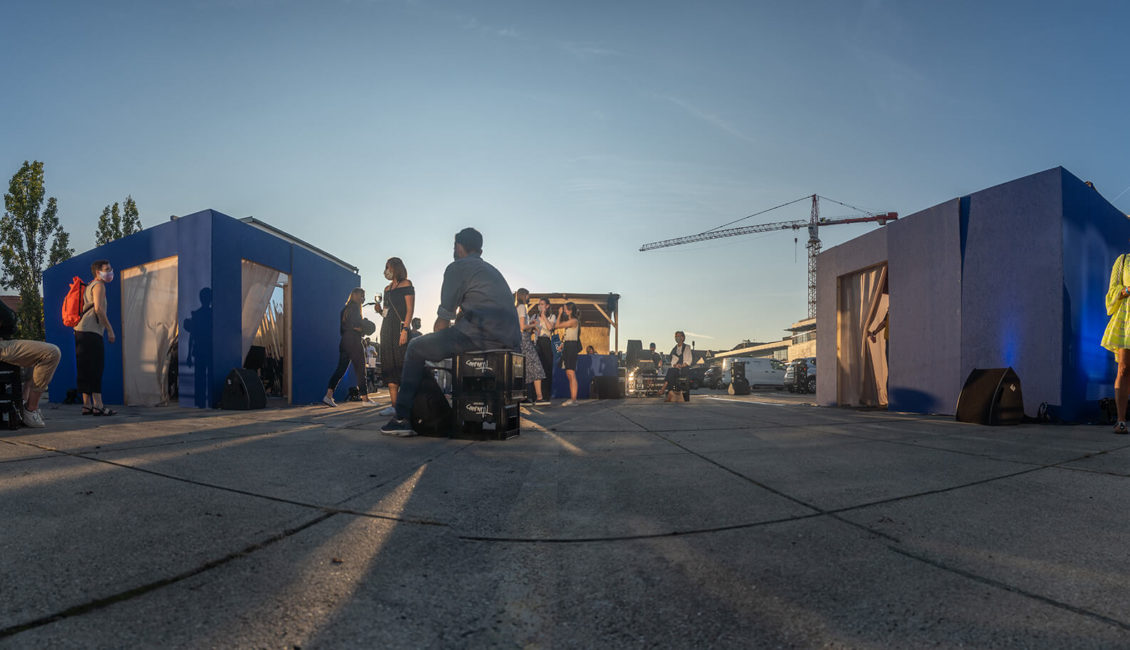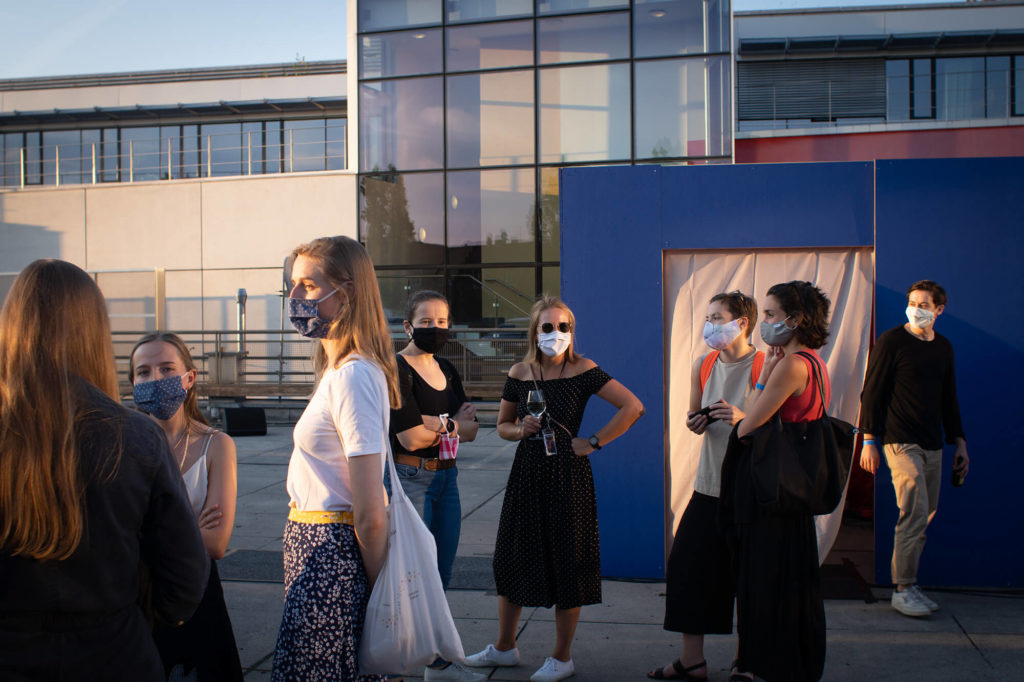
“A duration of one hour would be too harmless”
For five hours, three artists have to perform and improvise at the highest level in FERNSTE GELIEBTE – without being able to see each other. An emotional and physical ordeal that is crucial, as dramaturge
JULIAN KÄMPER
von trugschluss explains
Text:
Philipp Nowotny
– Photo:
Max Ott
HIDALGO: Julian, in a nutshell: What is FERNSTE GELIEBTE?
Julian Kämper: A walk-in concert installation based on the famous song cycle “An die ferne Geliebte” by Ludwig van Beethoven. The cycle deals centrally with insurmountable distance. We make this a real experience for both the performers and the audience.
Who is involved and in what role?
The mezzo-soprano Hagar Sharvit and the pianist and lyricist Daniel Gerzenberg take center stage. This togetherness of singing and accompaniment, so typical of the song genre, is radically broken up: With the sound artist Martine-Nicole Rojina, a trio is formed that acts musically with or against each other. The idea, staging, scenography and artistic realization come from the trugschluss collective. As a co-production partner, HIDALGO developed the artistic framework with us and made the realization possible.
Which art forms intertwine here?
The term “walk-in concert installation” already says it all: it’s first and foremost a concert because three musicians are making music. What is important and special is the aspect of the installation, i.e. that visitors can move individually through the events, decide for themselves what and when to focus on, and thus develop their own interpretation. The scenographic design adds something theatrical. Ultimately, it’s a hybrid that knows no clear boundaries – but that’s also the interesting thing.

You said at the beginning that FERNSTE GELIEBTE makes insurmountable distance tangible. What does Beethoven have to do with modern long-distance relationships, for example?
Beethoven’s cycle paints a very concrete picture: Someone sits on a hill, looks down into the valley and sees or hallucinates his former lover. This image certainly cannot be translated one-to-one into our present day, but there are numerous connections. In the past, it was not possible to cover large distances. Today, we are so mobile that we can easily travel the world – but that is precisely why we also enter into relationships, friendships or other relationships with people in other places. This means that people are no longer only connected to each other through physical proximity and physical contact, but also through modern communication media – we are all familiar with this due to coronavirus. In the Beethoven cycle, it is kept open whether the lover has died or is absent due to spatial or social constraints. This is still relevant today: Wanting to be together, but not being able to be together due to internal or external circumstances. I think all of us are familiar with this.
FERNSTE GELIEBTE shows over five hours how Beethoven becomes increasingly lonely, right?
Yes, Beethoven’s biography is included here. What is central for us is the process of him gradually becoming isolated and deaf – through his (a)social behavior and the illness. One of the many means used by the sound artist is a tinitus-like background noise that almost threateningly drowns out all other sounds in the surroundings. This intermingles with the main thread of FERNSTE GELIEBTE: there are two people who actually belong together, in our case singer and pianist – but who are separated from each other at the beginning. Over several hours, we observe what this isolation and distancing does to them emotionally. At the end, the speakers open and the singer and pianist can see each other, but they can’t hear each other because they’re wearing noise-canceling headphones – whether this is a successful or unsuccessful coming together is up to you to decide.
The song cycle “An die ferne Geliebte” actually only lasts around 15 minutes. How do you turn it into a five-hour performance?
First of all, by thoroughly analyzing the music and texts of the Beethoven cycle and discussing them in the group. The smallest musical motifs, a change of chord or a single verse can contain entire worlds of thought, interpretations and narratives. We have stretched such key moments almost like super slow motion in order to savor, enjoy and intensify them. A single chord can stand and waft in the room for minutes, so that visitors can really move through the music and hear a sound from different positions. But we are not only stretching Beethoven’s original material, because the performance is full of free associations, improvisations, spontaneous interactions and material from high and pop culture. All of this is motivated by our engagement with the original cycle, but it can also be extremely different.

Do I have to be a Beethoven freak who knows all his works and has read all the books about him to understand the performance?
No. Quite simply because the basic situation of people who are actually acting together being physically separated from each other is a real situation that all visitors – regardless of their prior knowledge – can experience and understand directly.
One danger is that such productions can come across as too cerebral – were those involved aware of this?
Sure. We makers work long and hard on the material, reading, analyzing and discussing it down to the smallest detail. In this way, you acquire specific specialist knowledge that you cannot expect from the public. We want to impart this knowledge through direct, real-life experience. That is why we “translate” our themes and issues into spatial, physical and temporal dimensions, in other words, we tell them in a sensual way. The “informed visitor” with prior knowledge will repeatedly recognize references, quotations and reminiscences and have “aha” experiences. That’s good, but not a must – you can simply smile at certain situations, find them absurd, stupid or irritating without having to understand them.
Another danger is that the quality of the music suffers, right?
On the one hand, yes, because the concept requires the musicians to be separated from each other and thus to deliberately disrupt or at least impede the musical interplay. Distance is also a real hurdle here. On the other hand, we have musicians here who maintain the musical quality despite these obstacles because they have a perfect command of the cycle, because they react sensitively and attentively to the situation and because they are able to make supposed disruptive factors fruitful for the artistic result. The sound artist’s electronic soundscapes and samples add a level of their own that does not “disturb” the “classical” music, but combines with it to create something new.

How does the audience react? Which reactions are the most surprising?
Well, we are also playing with expectations. When I go to a concert, I expect the artists to be in the spotlight on a stage. But here the musicians are hidden, they are kept from me for the time being, so to speak. So I have to become active myself and overcome a boundary – that of the box – in order to have the actual live experience. This alone creates exciting dynamics between the visitors, who, for example, only dare to enter one of the boxes if they have seen others doing the same. If several people want to enter a box at the same time, they have to cooperate and agree on an order, as only one person is allowed in at a time. I think the whole thing is also a kind of audience performance.
And sometimes the audience itself becomes the performer, right?
Yes, it has happened that visitors have engaged the musicians in conversation while they are playing, which is audible to everyone thanks to the microphones. This also influences the further course of events. Something like this is unthinkable in a conventional concert.
How much of FERNSTE GELIEBTE is improvisation?
We only developed a rough schedule as a basic framework for the five hours. That’s why we had two performances in Munich that were completely different. The result depended on the audience, but also on the form of the day and the physical and emotional state of the performers.

It must be extremely stressful for the artists.
Absolutely! Playing music at the highest level for five hours and being constantly present is anything but day-to-day business. But it is precisely this borderline experience that we really want. A duration of one hour would be too harmless. Only after three to four hours do the performers reach their physical limits and really feel the longing to be able to see the others again and be freed from their isolation. So they don’t have to act this insurmountable distance, they actually live through it – and you can feel that in the performance. That is crucial!
In what setting could the production be staged again?
In principle, this is conceivable everywhere! In addition, the concept offers the freedom to respond to the surroundings and the spatial context in terms of content and to thematize it in the performance.
Would FERNSTE GELIEBTE also be conceivable on Zoom, Skype or Teams?
Of course, these video chat platforms are a symbol of using communication tools to overcome physical distance and compensate for a lack of physical proximity – with all the disruptive factors and deficits that such a video chat entails. Basically, we made an analog version of this.

